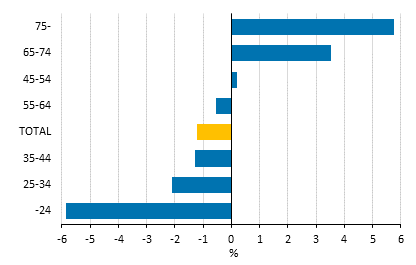Published: 1 April 2016
The recession has cut young people's income most
The data of Statistics Finland's income distribution statistics reveal that young people's economic situation has weakened most in the past years measured by income. Households where a person under the age of 25 is responsible for the primary livelihood have had the weakest income development. In 2014, the disposable median income in this age group was nearly six per cent lower than in 2010. In the age group of persons aged 25 to 34, income declined by two per cent and of persons aged 35 to 44 by one and a half per cent over the same time period.
Changes in households’ median income by the age group of the reference person in 2010 to 2014, %

Changes in income have been calculated from the median for households’ equivalent disposable monetary income. Equivalent income = household’s disposable monetary income dividet by the number of consumption units in the household
For the whole country, households' equivalent median income was good one per cent lower in real terms in 2014 than in 2010. Pensioner households have fared best in the recent recession years, as the ongoing recession has not affected their income as strongly as that of younger households. In the age group of persons 75 or older, real income in 2014 was nearly six per cent higher than in 2010. In the age group of persons aged 65 to 74, income grew by 3.5 per cent over the same time period.
The different income development between age groups is explained by the fact that the income of pensioner households is not as sensitive to cyclical variations as that of working-age people. Both during the recession in the 1990s and the economic downturn in recent years, the relative income position of pensioner households has improved compared with employee households. This is due to the stability of pension income, as no direct cuts have been directed to pensions even in economically difficult times. In contrast, wage and salary income and entrepreneurial income typical of working-age people is more sensitive to cyclical variations.
Even though the income development of pensioners has been more favourable in recent years than in other age groups, their income is clearly lower than that of working-age people. The equivalent median income of households aged 75 or older was only EUR 17,000 in 2014. The median income of households aged 65 to 74 was EUR 20,600. In the younger age group (aged under 25), households' income level was lower than that of pensioners. In this group, the equivalent median income was only EUR 13,600. Households, whose reference person is aged 45 to 54 had the highest income. The equivalent median income that considers the size and structural differences of households in the group was EUR 26,400 in 2014.
The examinations above were made with the median for equivalent disposable monetary income. The income concept is internationally comparable and it does not include imputed income items (such as income from owner-occupied dwellings) or sales profits. Comparisons by households' population group with different income concepts can be made with the help of the database tables of the income distribution statistics.
Source: Income Distribution Statistics 2014, Statistics Finland
Inquiries: Pekka Ruotsalainen 029 551 2610
Director in charge: Jari Tarkoma
- Tables
-
Tables in databases
Pick the data you need into tables, view the data as graphs, or download the data for your use.
Updated 01.04.2016
Official Statistics of Finland (OSF):
Income distribution statistics [e-publication].
ISSN=1799-1331. Income differentials between population subgroups 2014. Helsinki: Statistics Finland [referred: 27.12.2025].
Access method: http://stat.fi/til/tjt/2014/02/tjt_2014_02_2016-04-01_tie_001_en.html

